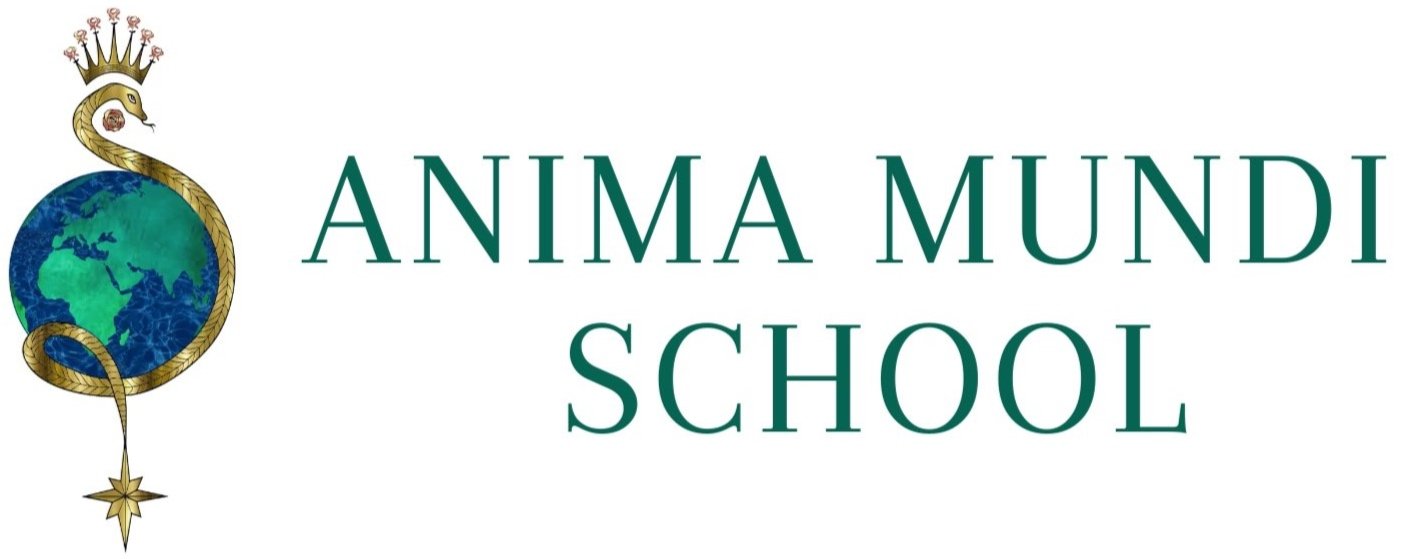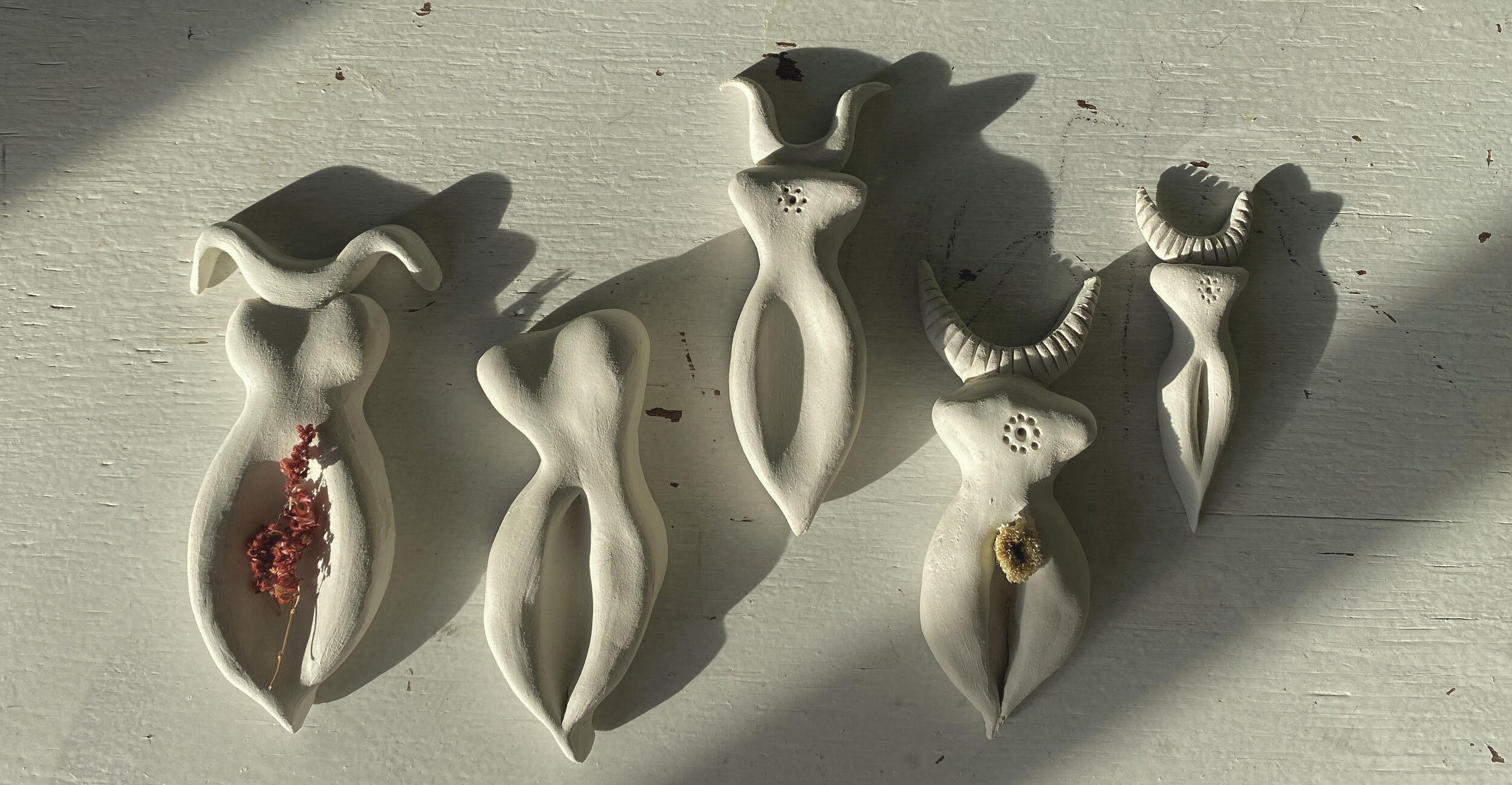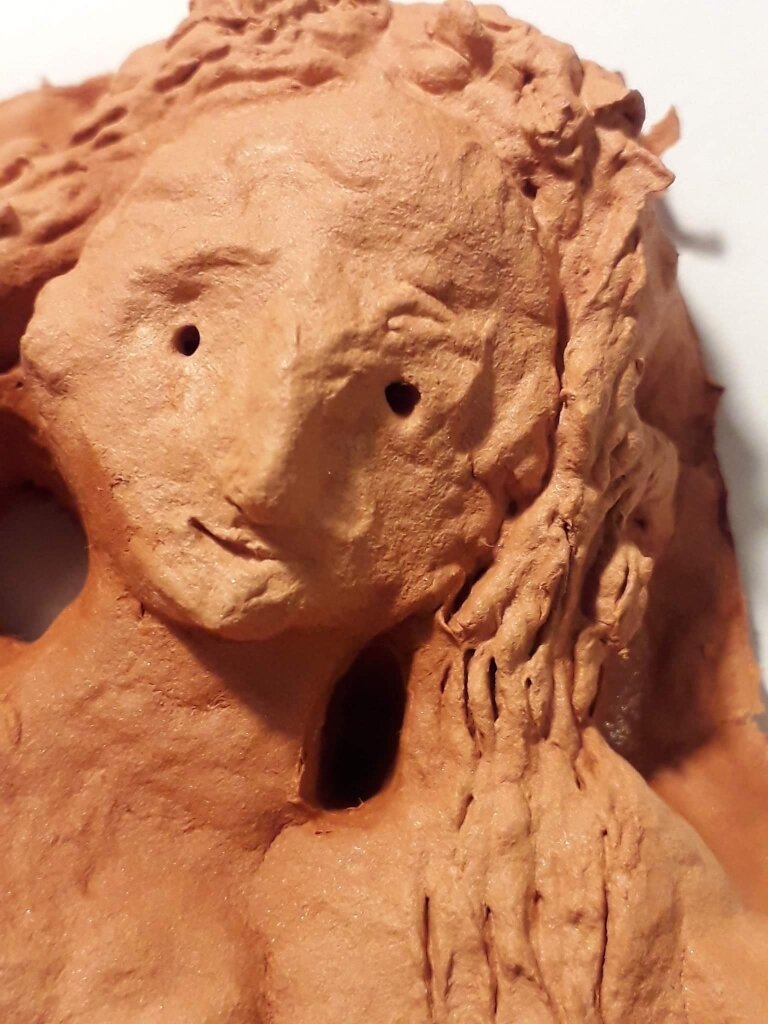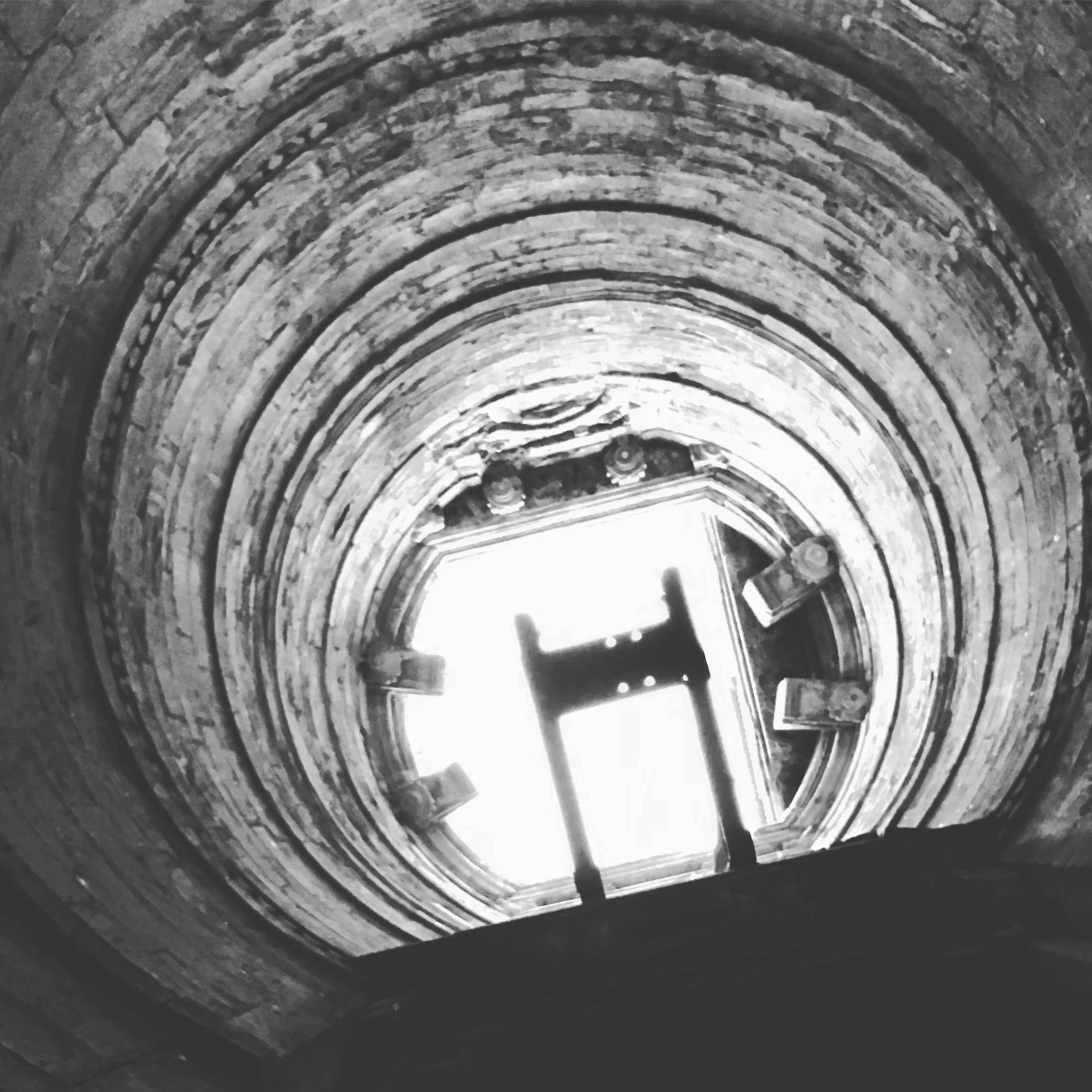Made of Dirt
finding solace in soil
by Faranak Mirjalili
by Faranak
To put our hands in the soil is to return to the origin, to the primal matter —the prima materia— of life itself. Over the past month, I’ve been finding solace, peace in putting my hands in soil, in the dust of clay and to listen to the song of my hands. What is born from the dance between dirt and touch? A sense of primal calm emerges in this meeting, which is distinctly different from for example drawing and painting.
For me, it has been the shape of vulva figurines that took over my hands. In her variety, she’s taken on a choreography of her own. Being Taurus in my sun sign, I’m not really surprised at this rather Venusian upwelling that emerged from the play of my hands.
by Laura Harris
It has been an equal joy to admire and reflect on the creations made by other women from the Reclaiming the Mythical Feminine program. There is something very magical about putting our hands into matter with the intent to create, to shape and to form. It is for a reason, that so many creation myths start with clay when they want to image the story of how God created humanity and the earth. To enact such a primal source of creativity is to connect again to our own origins, the way this love story began. Not through our minds, not even through our emotions, but through the naked and sensuous bliss of touch.
If we look at the origin of the word soil, and the Western use of it throughout history, it is not difficult for any other culture to understand our struggle with matter. There is a deep refusal that is even embedded in how the word has been used, originating in the 13th century.
soil verb (1)
soiled; soiling; soils
Definition of soil
1: to stain or defile morally : CORRUPT
2: to make unclean especially superficially : DIRTY
3: to blacken or taint (something, such as a person's reputation) by word or deed
: to become soiled or dirty
From the 13th century onward, the word soil has become associated with stain and corruption, something to be refused, rejected or at least purified. It has become associated with the Christian heritage of the fall of man to the sinful, terrible earth. Our place and home, and according to myth the very substance we are made of—the dust of the ground—has been rejected to its very core.
by Laura Krusemark
While working with clay, the soil of our Mother Earth, I felt not only how our earth as the embodiment of soil and the earthly has suffered so much rejection and abuse but also the ‘word’ itself. This glorious word soil, is only slightly different than the word soul.
Looking back even further, we find deeper meaning and solace in the word soil, our feminine nature (that of women and of men) can find a resting place in this word that is very close to our primal nature, the origin and the throne of life itself.
The etymology of the word soil roots us back to Latin: “solium” which literally translates as ‘seat, chair or throne’. Indeed, soil is the seat of life itself, it is the seat of our everyday life—even if we are not conscious of it. It is the skin of our Earth we walk upon, it is the seat of the vegetables that grow our everyday nourishment, the ground for so many of our medicine, herbs and teas. All of it comes from this great seat and throne of the Goddess, which holds life together as an interconnected whole. The ancient cultures that have collapsed, like the Mayan, Greek and Roman empires, mostly fell apart from poor soil management. If we do not take care of the throne, the seat and skin of our planet, what foundations do we have to live on?
But first thing’s first: we need a proper relationship again to both the word and the being of soil. There is a specific responsibility for women to reclaim this ancient relationship, for soil has been part of women’s mysteries from the beginning of time. It has been her connection to the Divine, as for women—God was always a Goddess before it became a bearded judgemental man, sitting on the cloud of our perfected minds.
Some of us may reclaim this relationship in gardening and growing food, in the forests or in our love for the soft, silky beach sand. Others might find this in the relationship to the matter of body or the play with clay. In whatever way we are called, the Earth, matter—Mother— is crying out to each of us uniquely.
The Soil of Inanna
by Anca Sira
In the myth of Inanna, the goddess descends into the Underworld to visit her sister Ereshkigal, queen of the dead. Inanna, as the Queen of Heaven and Earth has become—like many modern women today—spoiled by the comforts of civilization. She has forgotten that deep down in the Underworld there is a different world that is also part of her own nature. This cold, moist, dark place is a place where death, loss, and constraint rule over the myth of eternal progress. It is exactly here, that the Forever 21 image of our modern culture dies and collapses into the sobriety of an organic life.
Inanna has to learn that life is not complete without loss and death. That it is the fertile ground for new life and that her participation in the death cycle actually impregnates new life. It is only in the dance between life and death, that culture is born and renewed.
In many ways, Ereshkigal is like the wondrous earthworm, that turns the soil over and over, and creates life through the decay of old matter. Just like our modern culture has forgotten to praise all of the life underneath our feet that silently makes life fertile and abundant, Inanna has to learn that without Ereshkigal’s presence in the Underworld, she could not have become the Queen of the Earth and Heaven. She has to be humbled back into her relationship with primal dirt that sustains her. Humble comes from the Latin word humus, which takes us back again to that earthly ground that makes up the surface and skin of our beautiful Mother Earth.
Sacred Dirt
After thousands of years of patriarchy and an addiction to the perfection of light—be it the light of our minds or the light of a transcendent God—I believe and see in my work with women that time has come—even long overdue—that we really commit to finding again the sacred within matter. To recognise that the sacred is to be found in the prima materia of our world, in the difficulties and the places we might most resist, both inwardly and outwardly. A dream a friend had illustrates this very well:
“I’m walking with my friend along a street. It’s a wide statesque lane, it’s unpaved, the ground dark brown. We are sorting things out between us. First we walk on the right side and now we walk on the left. I walk a little slower when I see a beautiful huge dark brown cathedral, same colour as the soil, on my left. It has a big rosette. I know the Black Madonna is inside and I want to show my friend. She is with me again and at the foot of the steps to the cathedral is a little round tent shaped like an iglo. My friend goes inside and I follow. It’s muddy. She sits in the bigger part, I am in the front. Next to me (right) stands a wood carved Jesus. My friend takes it and holds it for a while. We are both silent. She then puts it back and puts her hands in the mud. From the mud she hauls a carved pig. The outline is not yet clear, but I can make it out enough. After this we go out and continue our path.”
In this dream, the dreamer is together with a female friend, sorting things out between each other. What then happens is that the image of the cathedral as well as the image of the Christ are echoed in its most primal form: the mud tent and the pig coming out of the mud. The sacred is as much to be found within the cathedral, as it is in a muddy, seemingly insignificant and dirty place. The illustration of the Christ being picked up, followed by the ‘drawing of the pig out of the mud’ shows that the sacred needs to be lifted and found within the heart of the soil, earth, and dirt. A pig, known to us in modern-day as the animal that is most dirty, even finds its comfort in the dirt, used to be a sacred symbol in more ancient cultures. She was sacred to many Earth goddesses and revered in matriarchal societies. The dream shows that the sacred is to be carved out of these most neglected and ordinary places.
When patriarchal cultures came and divorced the sacred from matter, we were left bereft of a deeper meaning of the ordinariness of our lives, our bodies, and this earth. These places, where once the sacred joy of life was pulsating, have become dormant and dis-eased, with the most devastating consequences for future generations ahead. It is now the time to reclaim this most ancient relationship as the Christ—the Divine within—is to be found within the dirt of life, the very dirt of which we are made.
Collective poem by Faranak, Gauri, Suzanne and Suzanna.
Collage art by Laura Krusemark.









